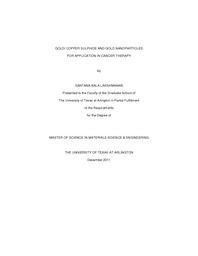
ATTENTION: The works hosted here are being migrated to a new repository that will consolidate resources, improve discoverability, and better show UTA's research impact on the global community. We will update authors as the migration progresses. Please see MavMatrix for more information.
Show simple item record
| dc.contributor.author | Lakshmanan, Santana Bala | en_US |
| dc.date.accessioned | 2012-04-11T20:55:48Z | |
| dc.date.available | 2012-04-11T20:55:48Z | |
| dc.date.issued | 2012-04-11 | |
| dc.date.submitted | January 2011 | en_US |
| dc.identifier.other | DISS-11460 | en_US |
| dc.identifier.uri | http://hdl.handle.net/10106/9563 | |
| dc.description.abstract | The main goal of this research is to use Gold/ Copper Sulphide (Au/ CuS) and Gold nanoparticles (AuNPs) for improving the therapeutic effects in the treatment of cancer. One of the biggest successes in photothermal therapy is the use of AuNPs which however has its own drawbacks i.e. it is expensive and that the NIR absorption of Au nanostructures is from surface plasmon resonance which is dependent on the dielectric constant of the surrounding matrix. Thus, the plasmon absorption maxima would shift for in-vivo observations compared to in-vitro. Alternatively, Copper Sulphide (CuS) nanoparticles, developed recently, have also been used for photothermal therapy. CuS nanoparticles are much cheaper than AuNPs, they have NIR absorptions around 900 nm which originates from the d-d transition of Cu 2+ ions and hence it is not sensitive to size, shape or solvents, but their photothermal conversion efficiency is much lower than that of Au. Therefore, in this work, we combined the above two nanoparticle systems and developed a new type of agent - Au/ CuS core/shell nanoparticles that have better photothermal conversion efficiency and also overcome the limitations of the existing nanoparticle systems for photothermal therapy. TEM, EDS and UV-Vis-NIR results confirmed the CuS coating on AuNPs. From UV-Vis-NIR spectroscopy we obtained that these core/shell nanoparticles have their maximum absorbance at 981 nm in the NIR region thus making them suitable for in vivo applications. Their absorption intensity was much higher than only Au and only CuS nanoparticles systems which in turn is responsible for their relatively high photothermal conversion efficiency. These core/ shell nanoparticles are also non-toxic and biocompatible and hence could be used for cell studies. Fluorescence properties of these Au/ CuS nanoparticles are an added advantage during photothermal treatment. They serve as fluorescent imaging agents for cancer cells and help in confirming the cellular uptake of nanoparticles. Photothermal studies proved the high photothermal conversion efficiency of Au/ CuS nanoparticles at laser powers much lower than the safety limit for human skin exposure. Recently, AuNPs have also been studied as a radiation dose enhancement agent. Therefore, in our research we also investigated the AuNPs as a radiosensitizer in an orthotopic human prostate cancer rat model. As the first step towards this goal, preliminary studies were carried out at the in vitro level with AuNPs for radiation enhancement in three different cancer cell lines. AuNPs of an optimum size of 50 nm were synthesized and characterized. All the three cell lines showed different radiation enhancement effects upon irradiation with AuNPs and radiation enhancement was observed especially at lower doses. | en_US |
| dc.description.sponsorship | Chen, Wei | en_US |
| dc.language.iso | en | en_US |
| dc.publisher | Materials Science & Engineering | en_US |
| dc.title | Gold/ Copper Sulphide And Gold Nanoparticles For Application In Cancer Therapy | en_US |
| dc.type | M.S. | en_US |
| dc.contributor.committeeChair | Chen, Wei | en_US |
| dc.degree.department | Materials Science & Engineering | en_US |
| dc.degree.discipline | Materials Science & Engineering | en_US |
| dc.degree.grantor | University of Texas at Arlington | en_US |
| dc.degree.level | masters | en_US |
| dc.degree.name | M.S. | en_US |
Files in this item
- Name:
- Lakshmanan_uta_2502M_11460.pdf
- Size:
- 4.221Mb
- Format:
- PDF
This item appears in the following Collection(s)
Show simple item record


